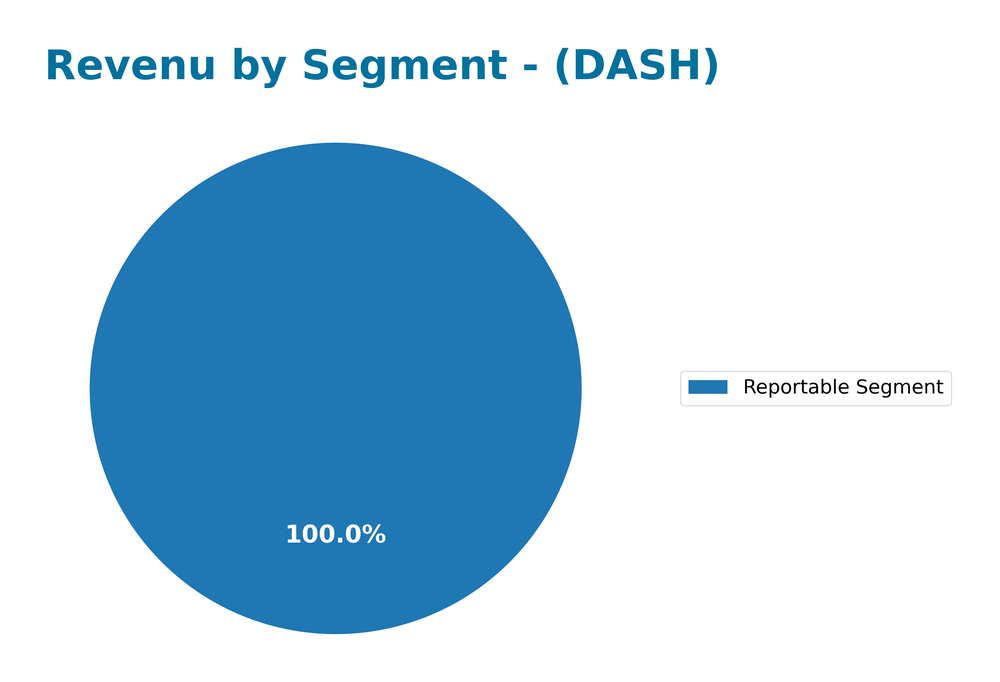Imagine a world where your favorite meals arrive at your doorstep with just a few taps on your smartphone. DoorDash, Inc. has revolutionized the food delivery industry, connecting consumers with local merchants and creating seamless logistics solutions. With its innovative platforms like DoorDash and Wolt, the company has established a reputation for quality service and market influence. As we assess DoorDash’s current standing, we must consider whether its fundamentals still justify its impressive market valuation and growth potential.

Table of contents
Company Description
DoorDash, Inc. is a leading logistics platform that connects merchants, consumers, and delivery drivers (dashers) across the United States and internationally. Founded in 2013 and headquartered in San Francisco, CA, the company operates popular marketplaces such as DoorDash and Wolt. It offers a suite of services that address critical challenges for merchants, including customer acquisition, delivery solutions, and analytics. With a workforce of approximately 23.7K employees, DoorDash is a significant player in the Internet Content & Information industry, continuously innovating its offerings through products like DashPass and Wolt Drive. The company’s strategic emphasis on expanding its marketplace ecosystem positions it as a transformative force in the logistics and delivery sector.
Fundamental Analysis
In this section, I will perform a fundamental analysis of DoorDash, Inc., focusing on its income statement, financial ratios, and dividend payout policy.
Income Statement
The following table summarizes the income statement for DoorDash, Inc. over the last five fiscal years, highlighting key financial metrics to assist in analyzing the company’s performance.

| Metrics | 2020 | 2021 | 2022 | 2023 | 2024 |
|---|---|---|---|---|---|
| Revenue | 2.886B | 4.888B | 6.583B | 8.635B | 10.722B |
| Cost of Revenue | 1.368B | 2.338B | 3.588B | 4.589B | 5.542B |
| Operating Expenses | 1.954B | 3.002B | 4.119B | 4.625B | 5.218B |
| Gross Profit | 1.518B | 2.550B | 2.995B | 4.046B | 5.180B |
| EBITDA | -306M | -296M | -663M | -68M | 523M |
| EBIT | -426M | -452M | -1.032B | -577M | -38M |
| Interest Expense | 32M | 14M | 2M | 0 | 0 |
| Net Income | -461M | -468M | -1.365B | -558M | 123M |
| EPS | -1.45 | -1.39 | -3.68 | -1.42 | 0.30 |
| Filing Date | 2021-03-05 | 2022-03-01 | 2023-02-27 | 2024-02-20 | 2025-02-14 |
Interpretation of Income Statement
Over the five-year period, DoorDash, Inc. experienced significant growth in revenue, increasing from 2.886B in 2020 to 10.722B in 2024. This upward trajectory indicates strong demand for their services. However, net income reflects a stark contrast, improving from a loss of 1.365B in 2022 to a profit of 123M in 2024. The gross profit margin has also shown improvement, indicating better cost management. The most recent year, 2024, marks a pivotal shift with positive net income and a significant EBITDA turnaround, suggesting that DoorDash is successfully navigating towards profitability while managing its operational expenses more effectively.
Financial Ratios
The following table summarizes the key financial ratios for DoorDash, Inc. (DASH) over the years.
| Ratios | 2020 | 2021 | 2022 | 2023 | 2024 |
|---|---|---|---|---|---|
| Net Margin | -15.97% | -9.57% | -20.73% | -6.46% | 1.15% |
| ROE | -9.81% | -10.03% | -20.21% | -8.20% | 1.58% |
| ROIC | -8.23% | -9.00% | -15.06% | -8.17% | -0.33% |
| P/E | -96.60 | -107.17 | -13.28 | -69.64 | 561.28 |
| P/B | 9.47 | 10.75 | 2.68 | 5.71 | 8.85 |
| Current Ratio | 3.94 | 2.59 | 1.86 | 1.64 | 1.66 |
| Quick Ratio | 3.94 | 2.59 | 1.86 | 1.64 | 1.66 |
| D/E | 0.13 | 0.09 | 0.08 | 0.08 | 0.04 |
| Debt-to-Assets | 9.71% | 5.86% | 5.22% | 4.82% | 4.17% |
| Interest Coverage | -13.63 | -32.29 | -562 | 0 | – |
| Asset Turnover | 0.45 | 0.72 | 0.67 | 0.80 | 0.83 |
| Fixed Asset Turnover | 6.99 | 6.62 | 6.14 | 7.52 | 9.19 |
| Dividend Yield | 0 | 0 | 0 | 0 | 0 |
Interpretation of Financial Ratios
Analyzing DoorDash, Inc. (DASH) for the fiscal year 2024, we see a mixed financial health picture. The current ratio of 1.66 indicates good liquidity, allowing the company to cover short-term obligations. However, the solvency ratio stands at a mere 0.14, raising concerns about long-term financial stability. Profitability ratios are weak, with a net profit margin of 1.15%, and EBIT margin in negative territory (-9.34%), reflecting ongoing operational challenges. The debt-to-equity ratio of 0.069 suggests low leverage, which is positive, but the overall price-to-earnings ratio is excessively high at 561.28, indicating the stock may be overvalued. Overall, while liquidity appears strong, profitability and solvency issues remain significant concerns.
Evolution of Financial Ratios
Over the past five years, DoorDash’s financial ratios indicate a decline in profitability, with both net and operating profit margins remaining negative. Conversely, liquidity has shown improvement, with the current ratio increasing from 1.86 in 2022 to 1.66 in 2024, suggesting better short-term financial health.
Distribution Policy
DoorDash, Inc. (DASH) does not currently pay dividends, which aligns with its strategy focused on reinvesting in growth and innovation. The company is in a high-growth phase, prioritizing research and development over shareholder distributions. Notably, DoorDash has engaged in share buybacks, indicating a commitment to returning value to shareholders without traditional dividends. This approach, while risky, may support long-term value creation if managed effectively and if future profitability improves.
Sector Analysis
DoorDash, Inc. operates in the Internet Content & Information industry, providing a logistics platform that connects merchants and consumers through delivery services. Its competitive advantages include strong brand recognition and diversified service offerings.
Strategic Positioning
DoorDash, Inc. (DASH) holds a significant market share in the food delivery industry, benefiting from its comprehensive logistics platform that connects merchants and consumers. As of 2025, the company faces competitive pressure from rivals like Uber Eats and Grubhub, which are also innovating rapidly. The market is experiencing technological disruptions, such as the rise of autonomous delivery solutions, which could reshape service dynamics. Despite these challenges, DoorDash’s diverse offerings, including DashPass and Bbot digital solutions, position it well to maintain its competitive edge and adapt to changing consumer preferences.
Revenue by Segment
The chart illustrates DoorDash’s revenue distribution across its reportable segments for the fiscal years 2020 to 2024.

Analyzing the revenue trends, DoorDash’s overall business has shown significant growth, particularly in the “Marketplaces and Platform Services,” which escalated from 2.9B in 2020 to 8.6B in 2023. The most recent figure for the “Reportable Segment” in 2024 is 10.7B, indicating a continuing upward trajectory; however, growth rates may be slowing as the company matures. It’s important to monitor potential margin risks as competition intensifies and market saturation increases, which could impact revenue concentrations in key segments.
Key Products
Below is a table summarizing the key products offered by DoorDash, Inc. that contribute to its business operations and revenue generation.
| Product | Description |
|---|---|
| DoorDash Marketplace | A logistics platform that connects consumers with local merchants for food delivery, providing a wide range of cuisines. |
| Wolt Marketplace | An international delivery service that offers food and other products, operating primarily in European markets. |
| DashPass | A subscription service that provides members with unlimited free delivery on eligible orders, enhancing customer loyalty. |
| Wolt+ | Similar to DashPass, it offers subscription benefits for Wolt users, including discounts and priority delivery. |
| DoorDash Drive | A white-label delivery service that allows merchants to use DoorDash’s logistics for their own delivery needs. |
| DoorDash Storefront | A tool that enables merchants to create an online storefront for direct-to-consumer sales, facilitating e-commerce. |
| Bbot | A digital ordering and payment solution that integrates with in-store and online channels, streamlining the customer experience. |
These products reflect DoorDash’s commitment to enhancing delivery services and providing comprehensive solutions for merchants and consumers alike.
Main Competitors
In the competitive landscape of the Internet Content & Information sector, DoorDash, Inc. faces several formidable rivals. Below is a table of the main competitors, including DoorDash itself, sorted by descending market cap:
| Company | Market Cap |
|---|---|
| AT&T Inc. | 179.22B |
| Spotify Technology S.A. | 115.64B |
| Comcast Corporation | 99.52B |
| DoorDash, Inc. | 96.97B |
| RELX Plc | 73.98B |
| América Móvil, S.A.B. de C.V. | 64.71B |
| Reddit, Inc. | 44.36B |
| Baidu, Inc. | 42.61B |
| Tencent Music Entertainment Group | 28.48B |
| Nebius Group N.V. | 21.39B |
The primary competitors of DoorDash operate mainly in North America and globally, each providing various services that often overlap with DoorDash’s core logistics and delivery offerings. As an investor, it is crucial to monitor how these companies evolve and compete in this dynamic market.
Competitive Advantages
DoorDash, Inc. (DASH) boasts a strong competitive position in the logistics sector, driven by its extensive network of merchants and consumers, and innovative technology. The company’s unique offerings, such as DashPass and Wolt+, enhance customer loyalty while their white-label services like DoorDash Drive help expand merchant reach. Looking ahead, DoorDash is well-positioned to tap into emerging markets and introduce new products that cater to evolving consumer preferences. As the demand for on-demand delivery continues to grow, I foresee substantial growth opportunities that could bolster market share and profitability in the coming years.
SWOT Analysis
This analysis provides a framework to evaluate DoorDash, Inc.’s current position and strategic outlook.
Strengths
- Strong market presence
- Diverse service offerings
- High customer retention
Weaknesses
- No dividends paid
- High dependency on delivery logistics
- Competitive market
Opportunities
- Expansion into new markets
- Growth in e-commerce
- Partnership opportunities
Threats
- Regulatory challenges
- Intense competition
- Economic downturns
Overall, DoorDash’s strengths position it well for growth, especially with opportunities in emerging markets. However, management must address weaknesses and remain vigilant against external threats to enhance its strategic resilience.
Stock Analysis
Over the past year, DoorDash, Inc. (DASH) has exhibited significant price movements, reflecting both bullish trends and notable volatility in trading dynamics.

Trend Analysis
Analyzing the overall price change for DASH over the past year reveals a remarkable increase of 116.08%. This substantial growth indicates a bullish trend for the stock. However, the trend has shown signs of deceleration, with notable highs reaching $271.22 and lows at $104.13. The standard deviation of 50.49 suggests a considerable amount of volatility, indicating that while the stock has appreciated significantly, fluctuations in price have been noteworthy.
Volume Analysis
In the last three months, the total trading volume for DASH was approximately 2.38B shares, with 1.43B shares attributed to buyers and 940M shares to sellers. The overall volume trend is increasing, with buyers accounting for 59.9% of the activity, suggesting a generally positive investor sentiment. However, in the recent period, from September 21, 2025, to December 7, 2025, buyer volume decreased to 123M shares, while seller volume increased to 167M shares, indicating a slightly seller-dominant market. This shift may reflect caution among investors despite the longer-term bullish trend.
Analyst Opinions
Recent analyst recommendations for DoorDash, Inc. (DASH) indicate a cautious stance. Analysts have assigned a B- rating, reflecting a consensus leaning towards a hold position. Key arguments from analysts include solid return on equity and assets, but concerns around the company’s price-to-earnings and price-to-book ratios. While some view potential upside in the long term, the overall sentiment suggests that investors should be cautious. The consensus for this year remains a hold, as the company navigates current market challenges.
Stock Grades
The latest stock ratings for DoorDash, Inc. (DASH) reflect a generally positive trend among analysts.
| Grading Company | Action | New Grade | Date |
|---|---|---|---|
| Jefferies | Upgrade | Buy | 2025-11-19 |
| Guggenheim | Maintain | Buy | 2025-11-19 |
| Needham | Maintain | Buy | 2025-11-14 |
| Wedbush | Upgrade | Outperform | 2025-11-13 |
| Mizuho | Maintain | Outperform | 2025-11-12 |
| Susquehanna | Maintain | Positive | 2025-11-07 |
| Goldman Sachs | Maintain | Buy | 2025-11-07 |
| JP Morgan | Maintain | Overweight | 2025-11-06 |
| DA Davidson | Maintain | Neutral | 2025-11-06 |
| Cantor Fitzgerald | Maintain | Overweight | 2025-11-06 |
Overall, the trend indicates a positive outlook, with multiple upgrades and a consistent recommendation to buy or outperform from several reputable firms. This suggests that investor sentiment may be shifting favorably towards DoorDash as it navigates current market conditions.
Target Prices
The consensus target price for DoorDash, Inc. (DASH) reflects a positive outlook among analysts.
| Target High | Target Low | Consensus |
|---|---|---|
| 350 | 239 | 297.44 |
Analysts expect DoorDash’s stock to reach a consensus price of approximately 297.44, with a high of 350 and a low of 239, indicating a favorable sentiment.
Consumer Opinions
Consumer sentiment surrounding DoorDash, Inc. (DASH) reveals a mix of satisfaction and areas for improvement, reflecting the diverse experiences of its users.
| Positive Reviews | Negative Reviews |
|---|---|
| “Quick delivery and excellent service!” | “High delivery fees can be off-putting.” |
| “Wide selection of restaurants available.” | “Occasionally receives wrong orders.” |
| “User-friendly app makes ordering easy.” | “Customer service could be improved.” |
Overall, consumer feedback for DoorDash highlights strengths in delivery speed and variety of options, while concerns about delivery fees and customer service persist.
Risk Analysis
In evaluating DoorDash, Inc. (DASH), it’s essential to understand the potential risks that could affect its performance and your investment decisions. Below is a table summarizing significant risks.
| Category | Description | Probability | Impact |
|---|---|---|---|
| Market Risk | Fluctuations in demand for food delivery services. | High | High |
| Competition | Increasing competition from other delivery services. | High | High |
| Regulatory | Changes in regulations affecting gig economy workers. | Medium | High |
| Technology | Risks of system outages or cybersecurity breaches. | Medium | Medium |
| Economic | Economic downturns affecting consumer spending. | Medium | High |
The most pressing risks for DASH involve high competition and market fluctuations, which can heavily impact revenue. Recent trends show a surge in consumer preference for alternative delivery options, potentially squeezing margins.
Should You Buy DoorDash, Inc.?
DoorDash, Inc. (DASH) has demonstrated a profitability profile with a net income of 123M in FY 2024, reflecting a positive net margin of 1.15%. However, the company is currently experiencing value destruction, as its return on invested capital (ROIC) of -0.33% is below the weighted average cost of capital (WACC) of 11.68%. The firm maintains a relatively low debt ratio with total debt at 536M, resulting in a debt-to-equity ratio of 0.0687. The overall rating is B-, indicating moderate performance with room for improvement in operational efficiency and profitability.
Favorable signals
DoorDash, Inc. presents several favorable elements in its income statement evaluation. The company has achieved a revenue growth of 24.17%, a gross margin of 48.31%, and a significant gross profit growth of 28.03%. Additionally, operating expenses compared to revenue growth are at 24.17%, indicating effective cost management. The EBIT margin has improved with an impressive growth rate of 93.41%, and net margin growth stands at 117.75%. Furthermore, the EPS growth is notable at 120.42%.
Unfavorable signals
However, there are significant unfavorable signals to consider. The EBIT margin is currently at -0.35%, which suggests operational challenges. From the ratios evaluation, both the ROIC at -0.33% and the WACC at 11.68% indicate value destruction, as the cost of capital significantly exceeds returns. Additionally, the price-to-earnings ratio is exceedingly high at 561.28, and the price-to-book ratio is also elevated at 8.85. The interest coverage ratio is at 0, reflecting potential difficulties in meeting interest obligations. The net margin stands at 1.15%, which is also unfavorable.
Conclusion
In summary, while DoorDash shows a favorable outlook in terms of income statement performance, the unfavorable indicators from the ratios evaluation raise concerns. Given that the long-term trend is bullish but recent seller volume exceeds buyer volume, it might be prudent to wait for a more favorable buying scenario to emerge.
Disclaimer: This article is not financial advice. Each investor is responsible for their own investment decisions.
Additional Resources
- DoorDash, Inc. (DASH): A Bull Case Theory – Yahoo Finance (Dec 04, 2025)
- DoorDash (DASH) Stock Rallies as $100 Million Insider Bet and Analyst Upgrades Clash With Amazon’s 30‑Minute Delivery Push – ts2.tech (Dec 03, 2025)
- DoorDash, Inc. $DASH Shares Bought by Mackenzie Financial Corp – MarketBeat (Dec 03, 2025)
- Why Is DoorDash (DASH) Up 12.6% Since Last Earnings Report? – sharewise.com (Dec 05, 2025)
- Insider Selling: Gordon Lee Sells 2,159 Shares of DoorDash Inc (DASH) – GuruFocus (Dec 04, 2025)
For more information about DoorDash, Inc., please visit the official website: doordash.com



